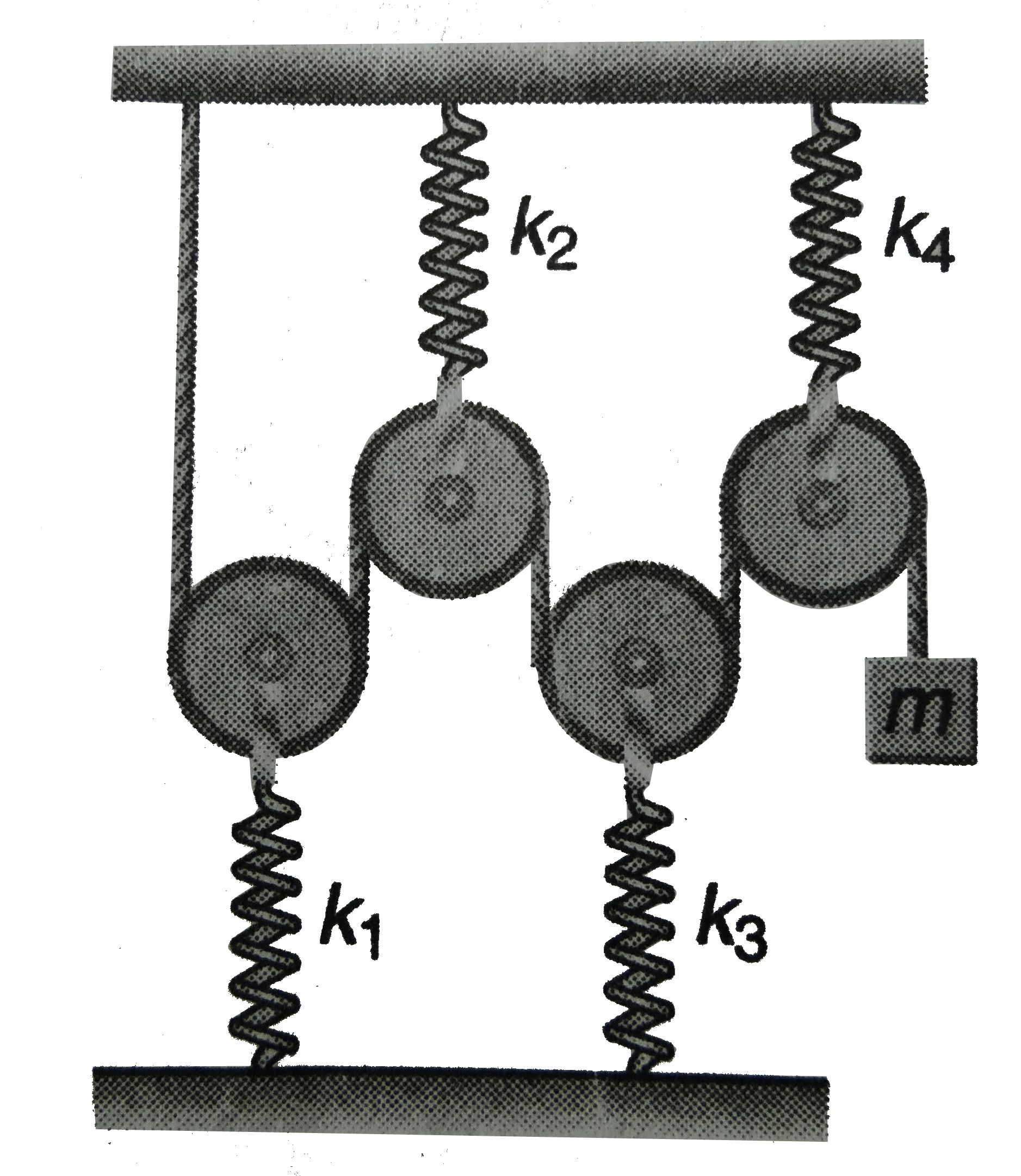A particle executing a linear SHM has velocities of 8 m/s, 7 m/s and 4 m/s, respectively at three points at distances of x m, (x+1) m and (x+2)m from the mean position. What is the maximum velocity of the particle ?Solution in Gujrati
Energy at all the three points are equal
_E01_097_Q01.png)
12mv21+12kx2=12mv22+12k(x+1)2
12m(64)+12kx2=12m(49)+12k(x+1)2
15=ω2+2ω2x…..(i)
12mv21=12kx2=12mv23+12k(x+2)2
12m(64)+12kx2=12m(16)+12k(x+2)2
12=ω2+ω2x.......(ii)
from (i) & (ii) ω=3 & x=1/3 then, total energy is equal for the maximum kinetic energy
12m(64)+12m19=12mv2max⇒vmax=√65m/s
Or
v=ω√a2−x2⇒8=ω√a2−x2
⇒7=ω√a2−(x+1)2,4=ω√a2−(x+2)2
After solving the equation
Vmax=aω=√65m/s
Topper's Solved these Questions
- SIMPLE HARMONIC MOTIONBook:ALLEN Chapter:SIMPLE HARMONIC MOTIONExercise:Exercise-04 [B]
Explore 104 Videos
- SIMPLE HARMONIC MOTIONBook:ALLEN Chapter:SIMPLE HARMONIC MOTIONExercise:Exercise-05 [A]
Explore 39 Videos
- SIMPLE HARMONIC MOTIONBook:ALLEN Chapter:SIMPLE HARMONIC MOTIONExercise:Comprehension Base Questions (5)
Explore 3 Videos
- RACEBook:ALLEN Chapter:RACEExercise:Basic Maths (Wave Motion & Dopplers Effect) (Stationary waves & doppler effect, beats)
Explore 25 Videos
- TEST PAPERBook:ALLEN Chapter:TEST PAPERExercise:PHYSICS
Explore 4 Videos
Similar Questions
In the arrangement shown in figure, pulleys are light and spring are ideal. K1, k2, k3and k4 are force constant of the spring. Calculate period of small vertical oscillations of block of mass m.

View SolutionIf a spring has time period T, and is cut into (n) equal parts, then the time period of each part will be.
View SolutionTwo particles A and B are performing SHM along x and y-axis respectively with equal amplitude and frequency of 2cm and 1Hz respectively. Equilibrium positions of the particles A and B are at the coordinates [3cm,0] and (0,4cm) respectively. At t=0,B is at its equilibrium position and moving towards the origin, while A is nearest to the origin and moving away from the origin-
Equation of motion of particle A can be written as-
View SolutionThe frequency of a radar is 780 MHz. After getting reflected from an approaching aeroplane, the apparent frequency is more than the actual frequency by 2.6 kHz. The aeroplane has a speed of
View SolutionChoose the correct statement:
View SolutionA particle in SHM has maximum velocity equals to 36 m/s and maximum acceleration of 216 pi m//s^(2) . The time period of SHM will be
View SolutionIn S.H.M., the velocity of the particle at the mean position is 1 m/s and acceleration at the extremity is 2m/s2, the period of motion is
View SolutionThe velocity of a particle performing S.H.M. are 0.13 m/s and 0.12 m/s. When it is at 0.12 m and 0.13 m from the mean position respectively. Then the amplitude is
View SolutionThe maximum velocity for particle in SHM is 0.16 m/s and maximum acceleration is 0.64 m//s^(2) . The amplitude is
View SolutionA particle executes a SHM of angular velocity 2 rad/s and maximum acceleration of 8m/s2. What is the path length of the oscillator ?
View SolutionA particle executes a linear S.H.M. of angular velocity 4 rad/s and maximum acceleration of 8m/s2. What is its path length ?
View Solutionकिसी गतिमान कण के वेग X व Y घटक क्रमश : 3 मी/से तथा 4 मी/से है । उसकी चाल ज्ञात कीजिये ।
View SolutionA particle travels A to M along a straight line with a velocity of 8 m/s and M to A with a velocity of 2 m/s,
then the average velocity for the whole journey is –
View Solutionएक सरल आवर्त गति करते कण का वेग 4 मीटर/सेकण्ड है, जबकि यह माध्य स्थिति से 3 मीटर दूरी पर है। जब यह माध्य स्थिति से 4 मीटर पर है तो वेग 3 मीटर/सेकण्ड है। धनात्मक अधिकतम विस्थापन की स्थिति से 2.5 मीटर की दूरी तक विस्थापित होने में कितना समय लेगा? हल-दिया है
View SolutionThe amplitude of a particle executing SHM is 0.1 m. The acceleration of the particle at a distance of 0.03 m from the equilibrium position is 0.12m⋅s−2. What will be its velocity at a distance of 0.08 m from the position of equilibrium?
View SolutionVelocities of a particle executing SHM are 4m*s^(-1)and3m*s^(-1) at distances 2 m and 3 m respectively from the position of equilibrium. Determine the amplitude and time period of the motion.
View Solution
